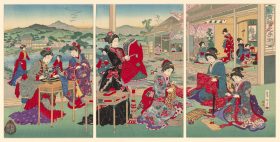Image: shutterstock.com
There’s a misconception that teaching represents some kind of failure. At the heart of this lies the tired saying, Those who can, do; those who can’t, teach. How did we come to see something as important as education in such a negative light?
Dr Renee Newman, an academic at the Western Australian Academy of Performing Arts (WAAPA), said the saying sits within a historical tradition of unhelpful binary thinking. ‘[It] says that the doers don’t think and the thinkers don’t do, or the warrior doesn’t farm and the athlete doesn’t play, or the man can’t care and the woman isn’t allowed to reason. It’s not only unhelpful or simplistic, it’s destructive and, to be honest, sad.’
Read: Empowering creative practitioners through research
It also overlooks a very important fact about teaching: it is, fundamentally, creative labour. ‘To teach is one of the most creative and innovative endeavours – we are forever having to make anew and to instil passion in knowledge creation. To me, knowledge encompasses all forms of creation,’ said Newman.
Professor Cameron Tonkinwise from the Faculty of Art and Design at UNSW agreed, adding that not only does the cliche ignore the creativity inherent in teaching, it also overlooks the fact that at one point even those who “can do” were taught.
‘This offensive cliche has no understanding of expertise – that it is precisely a moment at which you are able to articulate your own practice sufficiently to also then re-learn it. [It] knows nothing of the history of apprenticeship, the history of the university, the history of social change, the nature of post-natural evolution.’
The way we learn and work has changed significantly over time. Now, the expert learns to the point where they are able to then reshape their knowledge in their field or, perhaps, art form.
Read: Why creatives need to learn from each other
It’s a popular career choice for a reason
As a profession, teaching is a popular career choice for people who return to university. ‘Our most attractive programs at the moment, the most popular, are our education programs – undergraduate and postgraduate,’ said Julie Brunner, Online Academic Programs Coordinator at Curtin University. Such education programs are offered online through Open Universities Australia and often people choose them as a flexible way to change careers.
‘If you went to university and got an arts degree, and often people do that, they get an arts degree and become an artist and then five years down the track they want to start marketing themselves or want to start running their own business, and then come back for further study.’
Read: When it’s time to change careers
When it comes to the National Art School (NAS) in Sydney, the institutions philosophy is the flipside of the dismissive adage; here, those who can do, teach.
The NAS had built a reputation on the calibre of its teaching staff who are all practicing artists. In fact it was recently ranked number one art school in Australia for student satisfaction of that teaching experience, where intimate studios strengthen the connection between practice and education.
‘It is amazing how much the teachers can tease out of you in a short time,’ said Dr Ella Dreyfus, Head of Public Programs at NAS.
Read: How are bears and art students similar?
The same can be said of NIDA, where courses are taught by practicing artists as a way to blend academic and practical education and training.
Director of Acting John Bashford said: ‘In a context such as NIDA, it would be pointless to have those who can’t do teach, as our responsibility is to help our students become the best they can be in the industry. As a consequence, we engage those ‘who can do’ and have a track record to prove it to work with our students. This enables the conversation to begin between practitioner and emerging artist so that the professionalism and experience of these artists can help inspire the next generation.’
Read: The joy (and difficulty) of doing what you love
The combination of practice and teaching is also evident in the literary arts. ‘Students want published writers teaching them,’ explained Cassandra Atherton, lecturer in Creative Writing and the program coordinator of the Masters of Writing and Literature at Deakin University.
Teaching is also an important supplement to creative incomes and helps writers and artists to continue working creatively. ‘We have brilliant writers working in education. Coupled with the fact that writers need to make some kind of living – as writing doesn’t always provide a huge wage – complementing writing with teaching allows writers to work in their field and is incredibly rewarding. Of course, some writers choose to work part time so they have ample time to write.’
Read: New Masters program in writing and literature





